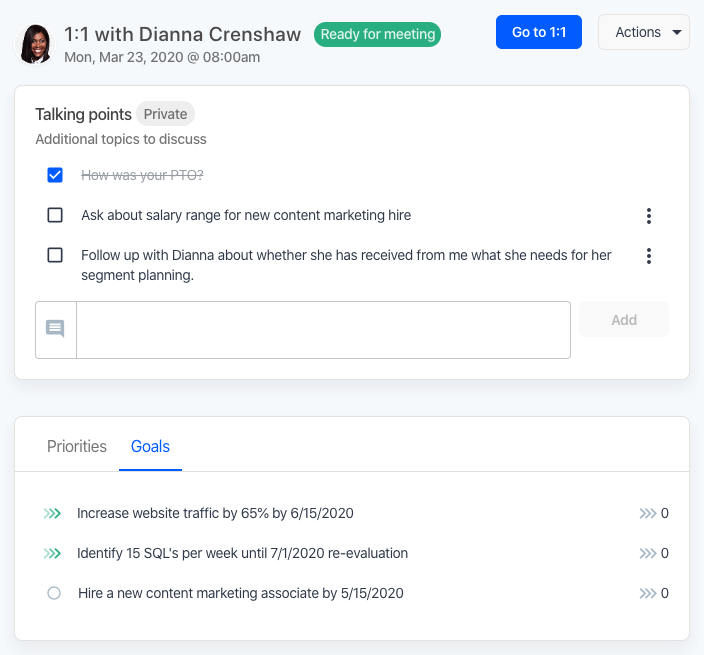One-on-ones can and should be some of your most valuable workplace interactions. Effective one-on-one meetings are essential to keep your team engaged and productive. They’re where you build relationships and loyalty. They’re where you and your team members have the conversations you couldn’t have in front of the rest of the team.
But seizing the potential of one-on-ones requires a different set of skills than the ones you use in the rest of your job. You need a clear vision of what you hope to achieve. Below, we’ll go over a few simple strategies to shift your mindset and start having more effective one-on-one meetings.
What Makes For Effective One-on-One Meetings?
You can tell the difference between a good and bad one-on-one meeting the same way you tell the difference between a good and bad oyster: the way it makes you feel afterward. If you’re doing it right, both you and your team member will walk away feeling energized, confident, and secure in your relationship.
Ask yourself these questions after a one-on-one, and you’ll quickly realize whether it was a truly valuable interaction:
- Did I deepen my relationship with this team member?
- Did we address their long-term professional development goals?
- Is this team member clear on what they need to do next?
- Did I listen as much as I talked?
- Did I offer support for problems? Am I prepared to follow up?
If the answer to all these questions is yes, then congratulations! You can stop reading now. But if you’re not hitting those benchmarks yet then read on.
Ditch the Status Updates and Have High-Value Conversations
Spending one-on-ones on status updates is like paying for a therapy session but only talking about the weather. It might be pleasant, but you could be getting more out of that time.

Use one-on-one meetings to have the sort of candid, personal conversations you couldn’t have in any other context. One-on-ones are when your employees should be their most honest with you. They’re the place for employees to share hopes and dreams, and tell you when they’re struggling. That’s all information you desperately need to support your team and catch issues before they get out of control. Building trust takes time, but it starts with laying a groundwork of personal care and knowledge of your team members.
Spend time in one-on-ones establishing this baseline with each employee, getting to know them as human being. Here are a few questions to start you off:
- How do you like to receive feedback? Face-to-face? Via email?
- What do you do when you get stuck on a problem? Ask for help? Dig in deeper?
- How important is praise to you? How about criticism? Do you respond more strongly to one or the other?
Hopefully, you’ve already asked these questions during onboarding. But even if it’s an employee you’ve worked with for years, it’s not too late to learn about who they are and what they need.
Would you like to boost productivity, increase trust and have a healthier, happier team?
Download your FREE 1:1 guide now!
Share Ownership of One-on-Ones with Your Team
Andy Grove, author of High Output Management and pioneer of one-on-one meetings, wrote that “the one-on-one should be regarded as the subordinate’s meeting, with its agenda and tone set by him.” That doesn’t mean that managers should come unprepared, of course. It means you have to respond to whatever your report needs from you that week.
One week, your report might be overwhelmed with projects and will want to discuss immediate solutions. Next week, they might have the bandwidth to think about larger goals, and you can advise them on big-picture issues.
The important thing is to recognize that this is their time, and it’s your job to be emotionally present. We’ve written before about how managers need to be like improv comedy performers and let one on ones go where they want to. That’s why the best one-on-one meeting agenda is a simple list of questions, starting with the all-important: “how are you?”

You can start sharing control of one-on-ones before they even begin. Ask team members to contribute their own items to the agenda. Ask them what they hope to get out of their time with you. Even when there are important topics you know you’ll have to cover (for instance, delivering critical feedback), come ready to listen more than you talk.
Collaborate on Goals
Managers and employees alike spend most of their days dealing with the nitty-gritty, in-the-trenches business of work. One-on-ones are a chance to step back, reflect, and make sure everyone is pointed in the right direction. The best way to do that is to set time aside in their one to one to identify their short-term priorities and long-term goals.
What’s the difference? Well, if a goal is the mountaintop an employee is trying to reach, then priorities are the boulders they have to climb over to get there. Priorities are tasks that should be achievable within a week or two, while goals might take months or even years to accomplish.
To set these long-term goals, ask a team member about their hopes and passions. Is there a position they’d like to attain, a new skill they’d like to learn, an idea they want to try out? Whatever their interest is, make it your business to harness it, and set them up for success. Naturally, those goals need to align with your team and your company’s needs. Goal-setting isn’t about developing employee skills in a vacuum. It’s about finding the overlap between individual and collective growth.
Maybe your employee has always wanted to master a piece of software but doesn’t know how to begin learning on their own. Together, set a goal of learning that software in six months and set a priority of doing an introductory course in the next week. Just like that, you’ve proved your commitment to the team member, and helped the company by training an employee to make greater contributions with more independence.
Of course, sometimes employees are too overwhelmed by day-to-day concerns to think very far ahead. On those days, your job is to help them put out their most immediate fires. If you sense an employee is overwhelmed, tell them to write down a list of their concerns. Go over it together, prioritize a few items, and develop an action plan for achieving them. Offer your perspective on where to start and reassure them that you don’t expect everything to be done overnight. Then they’ll walk out of that meeting confident they’re headed in the right direction. Keep doing that until they’re back in control of their workload.
Document One-on-Ones and Use Them Later
You can have the most meaningful, productive one-on-one of all time but it won’t matter if you forget what you talked about by the next time you meet. And when you’re managing a team of multiple people, it’s easy to lose track if you rely on memory. That’s why it’s crucial to keep organized notes from these meetings that you can reference at a glance.
Having a dedicated one on one platform like Uptick lets you turn the notes from one meeting into the next week’s agenda. You can set reminders for issues you want to circle back to and even search specific keywords.

Leveraging personalized agendas that evolve from your notes helps your one on ones evolve naturally over time. These notes can also help you detect patterns you might otherwise miss. For example, if an energetic employee is withdrawn three weeks in a row, you need to investigate the problem.
Keeping notes on what you and your team members discuss, and what goals you agree to, is vital to maintaining accountability. That way, when it’s time for promotions and performance reviews, you can draw on those records. And your notes will also keep you accountable for giving team members the support they need.
Effective One-on-One Meetings Help Everybody Win
If you take one-on-ones seriously, they can help you graduate from a “mere manager” to a true leader and mentor. At Uptick, we’re believers in the power of effective one on one meetings because we’ve witnessed it ourselves. We’ve built our platform to enable managers at every organization to implement the lessons we’ve learned. With the right tools and the right attitude, you can make one on ones the most rewarding part of your job.
Download your FREE Ultimate Guide to 1:1s
Learn how to have productive and meaningful conversations and boost productivity, increase trust and have a healthier, happier team!


